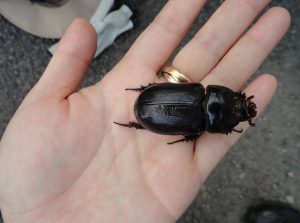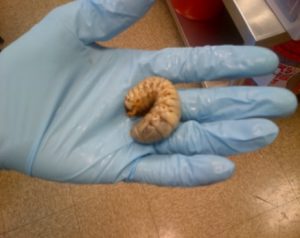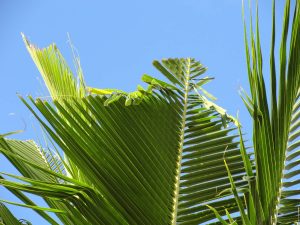Coconut Rhinoceros Beetles Detected on Kauai
Posted on Jun 5, 2023 in MainDepartment of Agriculture Focusing on Eradication
NR23-11
June 5, 2023
HONOLULU – Two coconut rhinoceros beetles (CRB) have been found on Kaua‘i, in traps near a green waste transfer station close to the Līhu‘e Airport. These are the first detections of CRB (Oryctes rhinoceros) outside of O‘ahu.
On May 31, a survey crew from the Kaua‘i Invasive Species Committee (KISC) found a live beetle in one of the traps near the green waste transfer station. On June 2, survey crews found a dead CRB in another trap nearby.
The Hawai‘i Department of Agriculture (HDOA) implemented an Incident Command Structure since CRB was first detected on O‘ahu in 2013 and will expand the use of the incident management system for the situation on Kaua‘i, with additional staffing from KISC. In addition, four members of the CRB Response Team on O‘ahu will be deployed to Kaua‘i this week to assist. Partner agencies include KISC, the Hawai‘i Invasive Species Council, the Department of Land and Natural Resources, the U.S. Department of Agriculture (USDA), and the Hawai‘i Department of Transportation. The University of Hawai‘i has also been an important collaborator in the CRB program, leading the effort to develop new CRB traps and using drone technology to apply insecticides.
“When CRB was first detected on O‘ahu about 10 years ago, early eradication efforts were hampered by the lack of funding and lack of information about the pest,” said Sharon Hurd, chairperson of the Hawai‘i Board of Agriculture. “We want to make sure this does not happen on Kaua‘i and we appreciate the assistance of partner agencies and all the research that has gone into CRB eradication and control.”
“Much has been learned over the past years about the CRB life cycle, detection, management, containment and treatment protocols,” said Helmuth Rogg, administrator of HDOA’s Plant Industry Division. “With these new detections on Kaua‘i, we are focusing a rapid response toward eradication.”
The response plan for Kaua‘i includes:
- Conducting visual surveys within a one-mile buffer zone of the first detections
- Deployment of additional traps at 25 priority sites, including the use of cameras and ultraviolet traps
- Possible fumigation of green waste at the transfer station
- Possible deployment of CRB-detector dogs after initial surveys by the response team
- Review of the possible pathways of introduction of CRB to uninfested areas
Surveillance for CRB has been ongoing on all neighbor islands, including Kaua‘i, where pheromone traps have been used for more than five years in strategic locations at Nāwiliwili Harbor and Līhu‘e Airport. The traps are used for early detection of CRB infestations. More than 3,000 CRB traps have been deployed around O‘ahu to track infestation areas.
Green waste provides an optimal breeding environment for CRB and residents on all islands are urged to check their compost bins and green waste for CRB larvae. In an effort to stop the spread of CRB to neighbor islands, HDOA issued an interim rule in July, 2022, restricting the movement of CRB host material within the island of O‘ahu and from O‘ahu to neighbor islands. CRB host material includes, but is not limited to, entire trees, green waste, compost, mulch, trimmings, fruit and vegetative scraps and decaying stumps of palm and palm-related plants.
The USDA currently provides the HDOA with about $2 million per year for CRB response efforts and about $350,000 per year for canine support. Additional moneys were appropriated this legislative session pending Governor’s approval.
CRB is a serious pest of palm trees, primarily coconut palms, as the adult beetles bore into the crowns of the palms to feed on the tree’s sap. New, unopened fronds are damaged in this way and when fully opened, may break and fall unexpectedly. If CRB kill or damage the growing point of the palm, the tree may die. Secondary fungal or bacterial pathogens may also attack the wounds caused by CRB, thereby killing the tree as well. Tree mortality after CRB attack has been reported to be anywhere from 10 percent to 50 percent. Dead trees then become a safety hazard as they may fall unexpectedly after the trunk rots, potentially resulting in bodily injury or property damage.
CRBs were first detected in Hawai‘i in Dec. 2013 at Joint Base Pearl Harbor-Hickam and have since been detected in West O‘ahu, from Māʻili to Pearl City and north to Kunia. Infestations have also been detected on the North Shore from Mokulē‘ia to Kahuku and in Waimānalo. There had been no detections of CRB on islands other than O‘ahu, until now. Tissue samples of the beetles found on Kaua‘i are being sent to the University of Hawai‘i for molecular identification analysis to try and trace the origin.
It is a major pest of palms in India, the Philippines, Palau, Fiji, Wallis, Nukunono, American and Western Samoa and Guam. It is still not known exactly how the beetles arrived in Hawai‘i.
Reports of possible CRB infestation may be addressed to the CRB Response Team at (808) 679-5244 or email [email protected] or the state’s toll-free Pest Hotline at (808) 643-PEST (7378).
For more information on CRB go to CRB Response webpage: https://www.crbhawaii.org/
Or the HDOA Plant Pest Control Branch New Pest Advisory: https://hdoa.hawaii.gov/pi/files/2013/01/npa-CRB-5-1-14.pdf
CRB Kauai Flyer: https://hdoa.hawaii.gov/wp-content/uploads/2023/06/CRB-Kauai-Flyer2.pdf
# # #



